As lovely and graceful as their name implies, the angelfish is a stunning jewel of the tank.
With an immense array of colors and patterns, one may think there are numerous species. However, there are only three freshwater angelfish:
- Angelfish (Pterophyllum scalare)
- Altum angelfish (Pterophyllum altum)
- Leopold’s angelfish (Pterophyllum leopoldi).
Scalare is the most frequently seen. This species has been extensively bred, resulting in an array of variations.
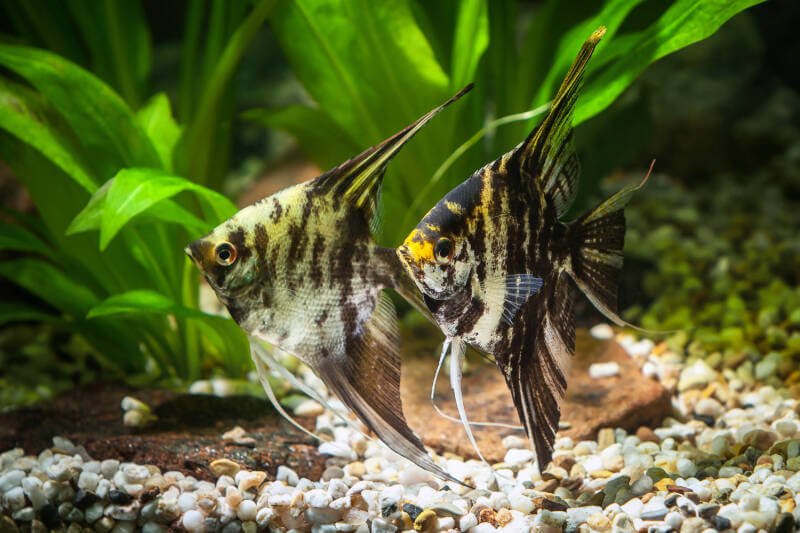
When selecting scalare for a community tank, keep in mind that some variations have longer fins than others, from the short-finned marble variation to the excessively long flowing fins of the veil angelfish.
The variation you choose allows some flexibility in tank mates. The angelfish is a hardy stock, but due to breeding practices, some are less hardy than others.
Altum is generally a wild-caught angelfish. As a result, its water parameters are slightly different.
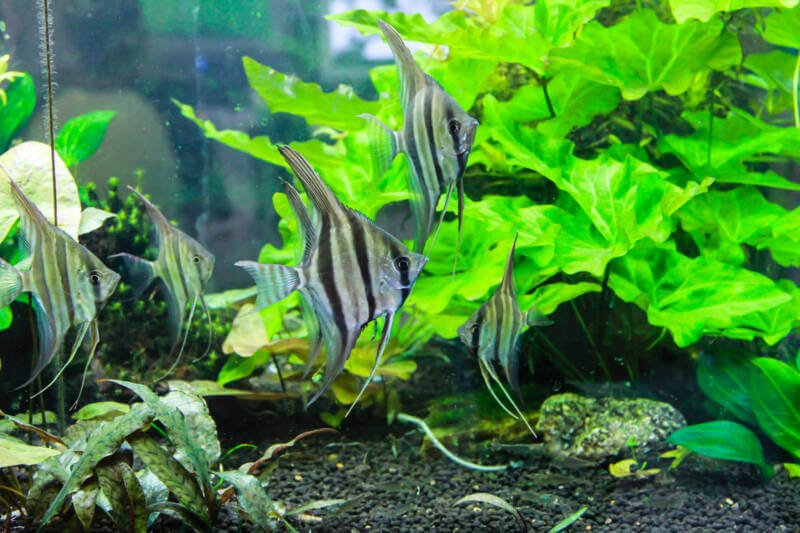
They prefer waters slightly warmer, around 82 – 90°F (28-32°C), slightly more acidic (pH 4.8 – 6.2), and softer (no higher than 5 dGH).
Leopoldi is another species that is typically wild-caught.
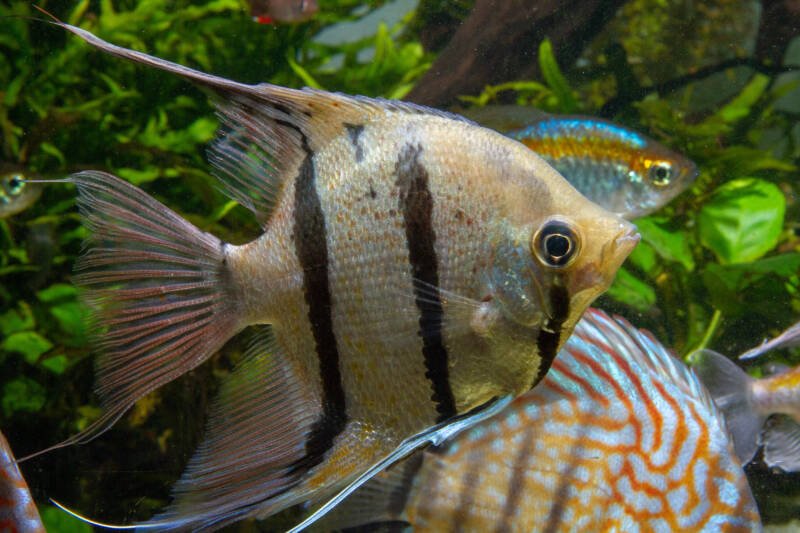
They grow smaller than the other two species, coming in at just under four inches in length (10 cm). Their water parameters match with the scalare’s.
In this article
Behavior
All species of angelfish are from the cichlid family native to South America.
They are curious fish that favor the middle level of the tank but love to explore all levels.
Keep them in a low-traffic area as they can startle at fast movements outside of the tank.
Angelfish are semi-aggressive, and their temper can increase as they age, as a result of overcrowding, or due to small tank size.
They do not need to be kept in a school and can thrive as a single specimen.
Feeding
Feeding time is one situation where you can expect your angelfish to be assertive.
They can easily outcompete other fish in the tank. Make sure all fish, especially bottom feeders if you have them, are receiving the nutrition they need.
Breeding
This species forms monogamous, bonded pairs that last the lifetime of the fish.
Angelfish will select and defend a territory, and this aggression can increase during breeding times.
Tank Setup
The angelfish’s natural waters are rich in vegetation with sandy bottoms. A similar tank setup is best.
Plan on a 30-gallon tank for a single fish and adjust upward for each additional fish.
Angels grow to a length of 6 to 8 inches (15-20 cm) and up to 10 inches (25 cm) in height.
A small or shallow tank will cause stress, which can lead to aggression or illness.
Angels are prone to ich with poor tank conditions, so be careful to not overstock and keep the water clean.
The temperature should be between 74 to 84°F (23-29°C), the pH slightly acidic between 6.0 and 7.0, and the hardness between 3 to 10 dGH.
Selecting Tank Mates
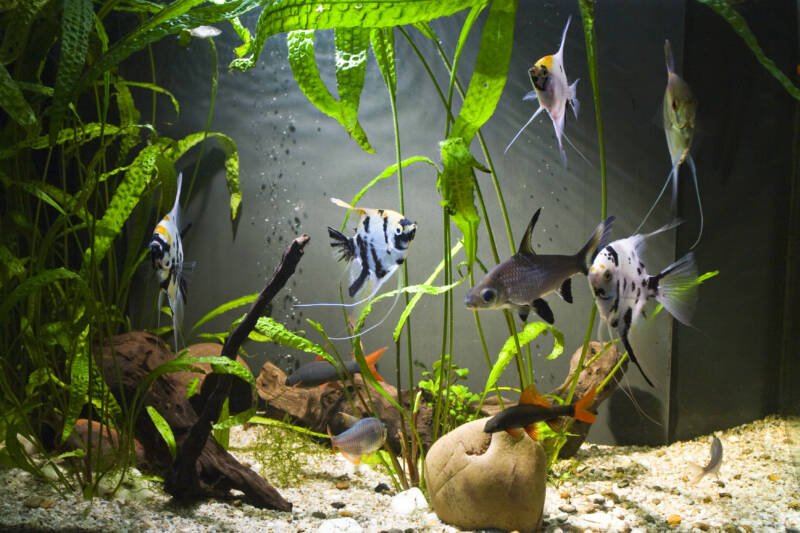
When choosing a fish to pair with your angel, look for fish that are:
- Fast swimming
- Short-finned
- Similarly sized
- Occupying other levels of the water column.
Avoid:
- Smaller fish (your angel may consider them food)
- Fish prone to fin nipping.
Recommended Angelfish Tank Mates
The following are some of our favorite fish to pair with angels.
1. Apistogramma Cichlid (genus)
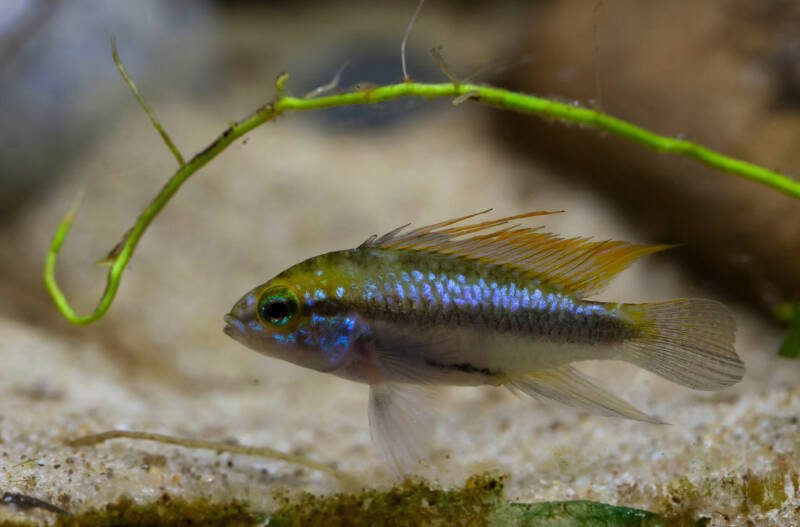
Minimum Tank Size: 20 gallons
The Apistogramma genus contains 90 beautiful species that are less aggressive than other cichlids.
They range in size from 0.8 to 3.1 inches (2-7.8 cm). Choose a larger variety to better match your angel’s size.
They favor the same water conditions, so that part of matching the two is easy.
Because these fish are smaller and favor the tank bottom, make sure that your angels do not eat all the food before it reaches your omnivorous apistogrammas.
Throwing in some high-quality sinking pellets can help.
Ensure the tank has enough space and dedicated hiding places that the fish can claim as territories.
2. Ram Cichlid (Mikrogeophagus altispinosus)
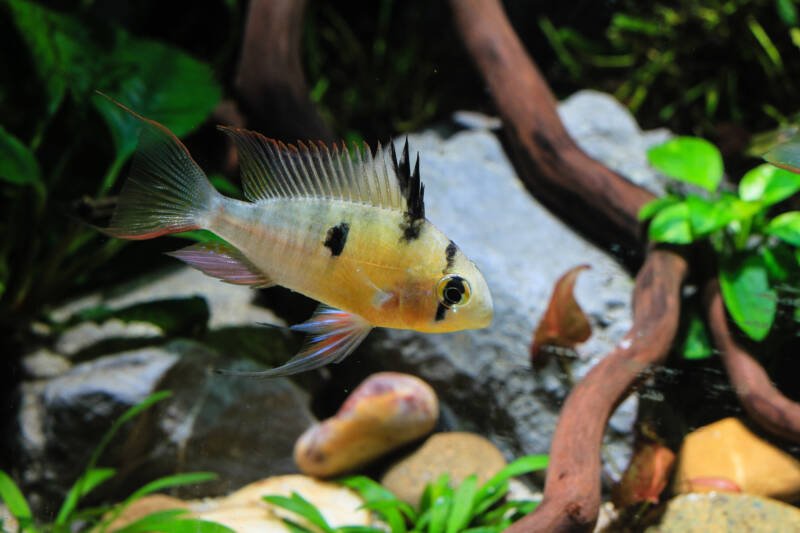
Minimum Tank Size: 30 gallons
The Bolivian ram is another great choice for a reasonably calm cichlid to pair with your angel.
Keep this species in a group of at least six to bring out their best behavior.
You may see some territorial aggression when they are ready to breed, but this is usually limited to guarding hiding places that the rams claim as territory.
They stay small, around three inches (7.6 cm) in length, but need plenty of swimming space.
As with the apistogramma, make sure your rams are getting the nutrition they need by feeding sinking pellets and other foods that will reach the tank bottom.
3. Albino Rainbow Shark (Epalzeorhynchos frenatum)
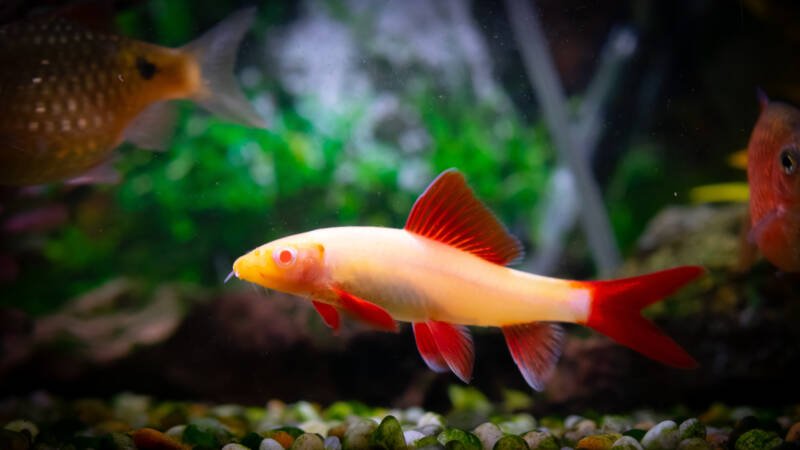
Minimum Tank Size: 50 gallons
This member of the minnow family brings a hefty name and a striking look.
Rainbows are classified as semi-aggressive due to their territorial nature, so plan on a large tank to give your fish the space they need.
The six-inch-long (15 cm) albino shark sticks to the bottom level, keeping it out of the angel’s way.
Make sure your angels and sharks are around the same size, introduce the albino to the tank last, and include plenty of hiding places to reduce territorial behavior.
If keeping more than one shark, plan on a group of at least five so that one does not get bullied.
4. Discus (Symphysodon genus)

Minimum Tank Size: 55 gallons
Imagine a tank full of tall, beautifully colored fish! A discus/angel pairing is not only visually appealing, these fish also match well in terms of water parameters, size, feeding, and behavior.
Feed your discus well and introduce them to the tank last to minimize territorial behavior.
Discus like their water on the warm side but well within the angel’s range.
Keep the pH consistent at 6.5 and the temperature between 82 to 84°F (28-29°C) where the two species’ needs overlap.
Tank size and shape are important for these tall species. Select a tank that provides both vertical and horizontal swimming space.
5. Bala Shark (Balantiocheilos melanopterus)
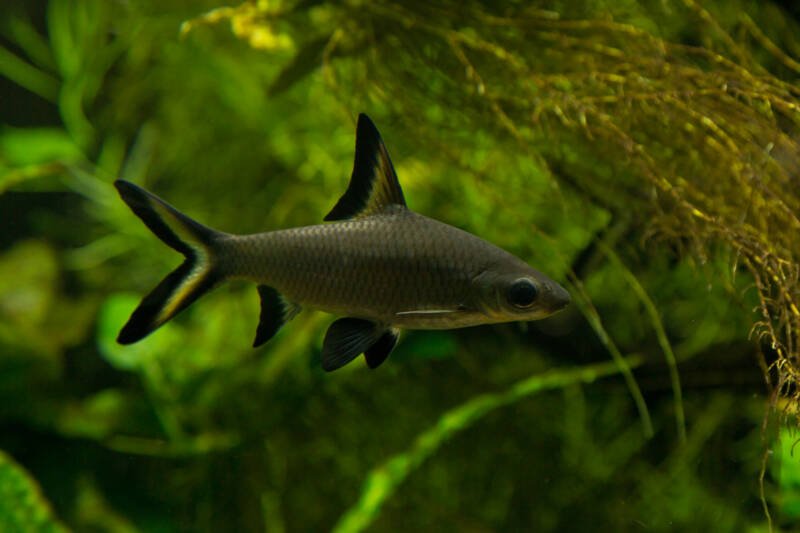
Minimum Tank Size: 120 gallons
The bala shark is valued as much for its peaceful nature as its good looks.
This fish is a model community tank member and does well in tanks with mid-sized fish, such as angels.
Water parameters are an easy match and the bala eats a wide variety of foods, making feeding simple.
Be aware: these fish quickly grow from the two-inch-long purchased cuties up to a foot in length (30 cm).
Calculate in the need of these fish to be kept in a group of at least six, and you are looking at a sizable tank.
6. Blue Acara (Andinoacara pulcher)
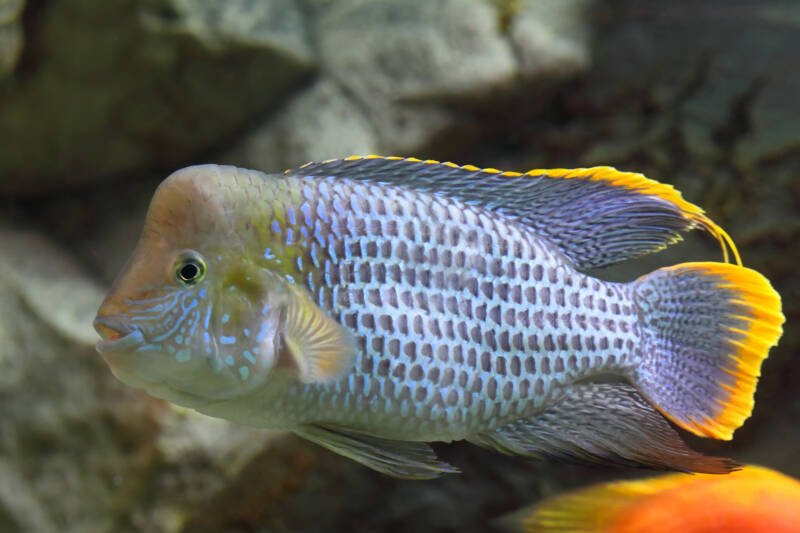
Minimum Tank Size: 30 gallons
The blue acara is a peaceful member of the cichlid family.
They are curious and a touch shy but get along well in both large and small community tanks with other peaceful species.
With this pairing, you may find your angel is the more aggressive of the two as the acara is only assertive during breeding.
This fish grows up to seven inches (18 cm), matching well with the angelfish’s adult length.
Their preferred water conditions line up, so tank setup is easy.
Like the angelfish, the acara can be enthusiastic when it comes to feeding time, so make sure all fish are getting nutrition.
7. Harlequin Rasbora (Trigonostigma heteromorpha)

Minimum Tank Size: 10 gallons
Harlequin rasboras are gentle and easy-to-care-for schooling fish.
This species will not nip at your angel’s fins and are one of the more peaceful community fish you can find.
They are most comfortable in a group of eight to 10 and are extraordinarily hardy.
The biggest challenge in pairing harlequins with angels is the size. Harlequins max out at two inches (5 cm) in length.
If they are small when you purchase them and your angels are large, then the angels may think you have provided them with a snack rather than tank mates.
Pair larger harlequins with smaller angels for best results.
8. Black Shark (Epalzeorhynchos bicolor)

Minimum Tank Size: 55 gallons
The black shark is also known as the red tail shark for its black body and bright red tail.
This fish grows to a length between four and six inches (10-15 cm) and tends to stay near the tank floor, reducing interaction with the angelfish.
Black sharks tend to get territorial when they are kept in too small of a tank.
They need adequate swimming space, so always go with a larger tank, especially when pairing them with angelfish.
Water parameters match well but keep the hardness toward the lower end of the black shark’s range to overlap with the angel’s.
9. Rainbowfish (Melanotaenia boesemani)

Minimum Tank Size: 30 gallons
The Boesemani brings beauty and a peaceful nature, making it an appealing community tank member.
They grow to 4.5 inches (11 cm) in length and are active swimmers, zipping through the middle level of the tank.
Rainbows are social fish that do best in groups of six. Keep the water’s pH close to neutral to match the angel’s.
Take care if selecting the Praecox rainbowfish (Melanotaenia praecox), which is the dwarf variation.
When you purchase these little guys, they are around an inch in length (2.5 cm) and only grow to a size of three inches (7.6 cm).
Your angel may view the smaller ones as food.
10. Tinfoil Barbs (Barbonymus schwanenfeldii)
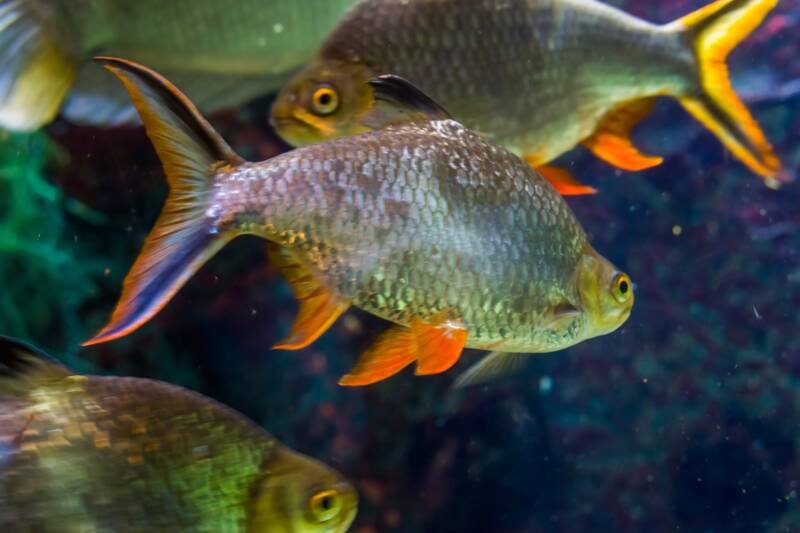
Minimum Tank Size: 75 gallons for a single fish
If you are going for a large tank setup, consider the tinfoil barb.
Absolutely gorgeous when schooling due to their glittering silver scales, these fish reach an adult length of 14 inches (35 cm).
They are best in a group of at least six to keep any aggression in check, so adjust tank sizes accordingly.
As far as tank setup goes, they match well with the angelfish. Both species enjoy swimming and occupy the same levels of the water column.
Remember that tinfoil barbs will snack on plants and eagerly consume any smaller fish, so make sure your angels are larger sized.
11. Cory Catfish (Corydoras)

Minimum Tank Size: 10 gallons
What would a fish list be without the cory? This peaceful species is a shy bottom dweller that stays out of the angelfish’s way.
Have plenty of hiding spaces along the tank bottom and keep a group of four to six corydoras for them to feel safe.
While the cory and angel match well in terms of water temperature and hardness, the pH can be tricky.
Wild-caught and captive-bred fish may have different needs, so check with the seller first.
The gold stripe corydora or the gold flash cory (Corydoras schultzei) are two that match the angel well.
12. Dwarf Gourami (Colisa ialia)
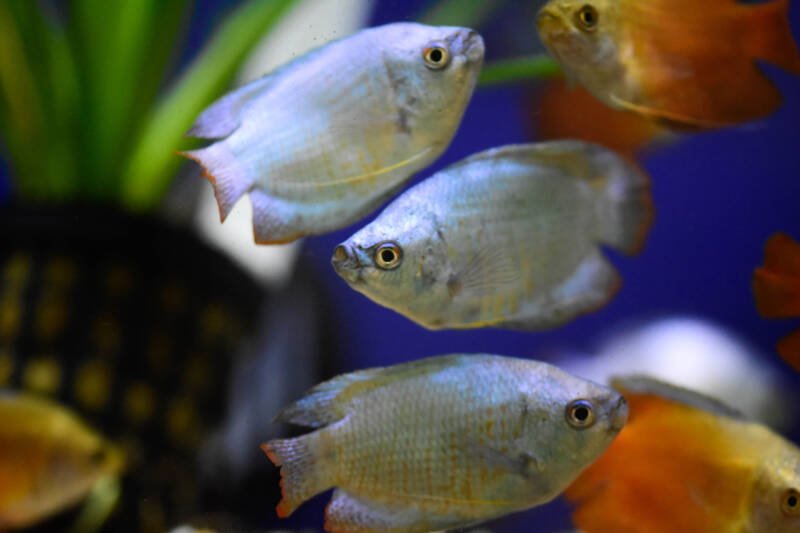
Minimum Tank Size: 10 gallons
The dwarf gourami is a more peaceful species than its larger brethren. However, they are not without internal squabbles.
Males can be territorial, so if you are keeping more than one fish, consider one male and multiple females.
These fish do not school but prefer to be in a group of six.
Gouramis love the same water conditions as the angelfish, from temperature down to minimal current.
Feeding them is a snap as these omnivores can both thrive on a diet of flakes supplemented with protein-rich foods.
Add the gentle gourami first to the tank to reduce territorial aggression by the angel.
13. Snakeskin Gourami (Trichopodus pectorali)

Minimum Tank Size: 30 gallons
The snakeskin gourami is a mild-tempered species, even during times of breeding.
Their calm personalities make them excellent angelfish partners as they will not provoke aggression.
These fish love the middle level of the water column but need access to the surface from time to time to breathe using their labyrinth organ.
These fish can get up to 10 inches in length (25 cm), but typically stay around six to eight inches (15-20 cm) in an aquarium setting.
Water parameters are broad for this species and accommodate the angelfish’s quite nicely. Plan on a heavily planted tank to make your gourami feel at home.
14. Opaline Gourami (Trichopodus trichopterus)
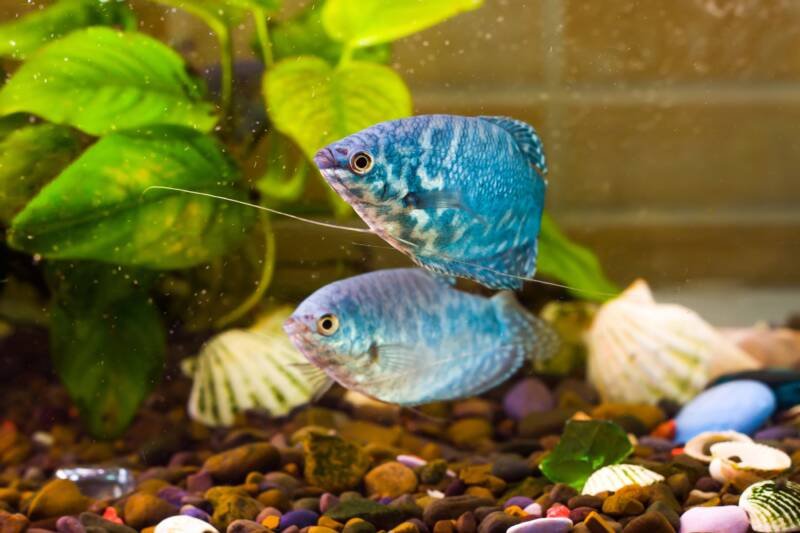
Minimum Tank Size: 35 gallons
Another labyrinth fish, the opaline gourami is beautifully patterned. These fish have a range of personality types, so how well they get along with your angels may come down to individual personalities.
When selecting an opaline, check for any deformities due to breeding practices of this “developed” species.
Water parameters, size, and tolerance of tank mates are all well matched with the angelfish.
Males can be slightly territorial during breeding. Feeding time is fun as opalines are just as enthusiastic as the angel!
Opalines can hunt smaller fish so select angels and opalines that are around the same size.
15. Featherfin Synodontis (Synodontis eupterus)
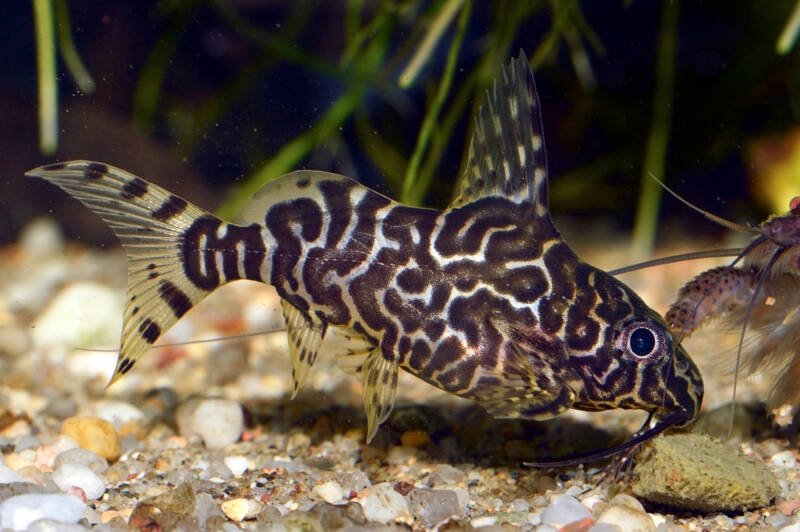
Minimum Tank Size: 29 gallons
Want a fish that can do something unique? The featherfin synodontis can swim upside down and squeak!
They grow up to a foot (30 cm) in length but usually stay closer to six to eight inches (15-20 cm) when in an aquarium.
They stay along the tank bottom, out of the angel’s way, and can be kept in a group or as a single specimen.
Featherfins can get aggressive as they age, but it does not extend beyond the species, especially if there are plenty of hiding spaces.
Set the water hardness on the lower end of the featherfin’s tolerance to match the angel’s.
16. Bristlenose Plecos (Ancistrus genus)
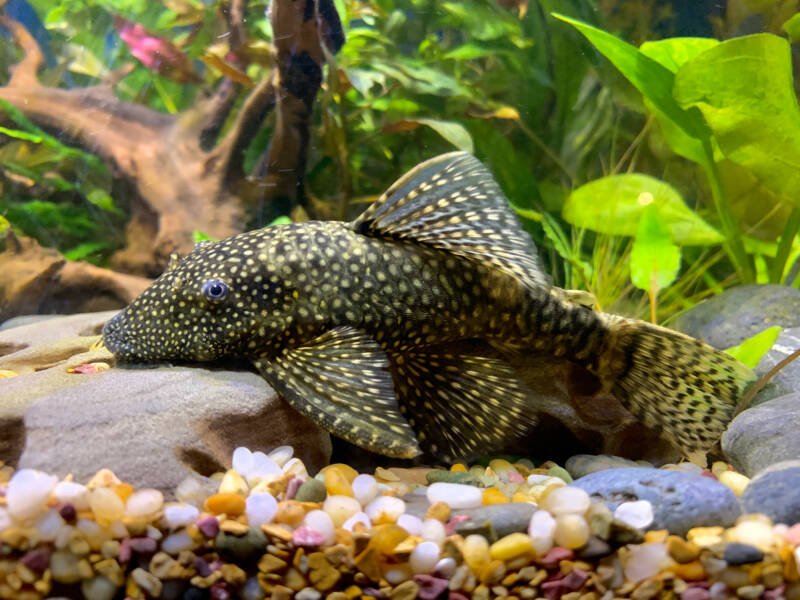
Minimum Tank Size: 25 gallons
Bristlenose plecos are charmingly funny-looking fish. They come in a variety of color forms and reach an adult length between three and five inches.
The fact that they are nocturnal bottom dwellers makes them an excellent angelfish match.
Bony dorsal plates protect these fish against curious tank mates. As with any bottom feeder, feed sinking pellets to make sure some food gets past your angels.
The bristlenose’s water condition tolerance range is so wide, you will have no problem setting the tank up to suit both species.
Keeping more than one bristlenose male in a tank may lead to aggression.
17. Kribensis Cichlid (Pelvicachromis pulcher)
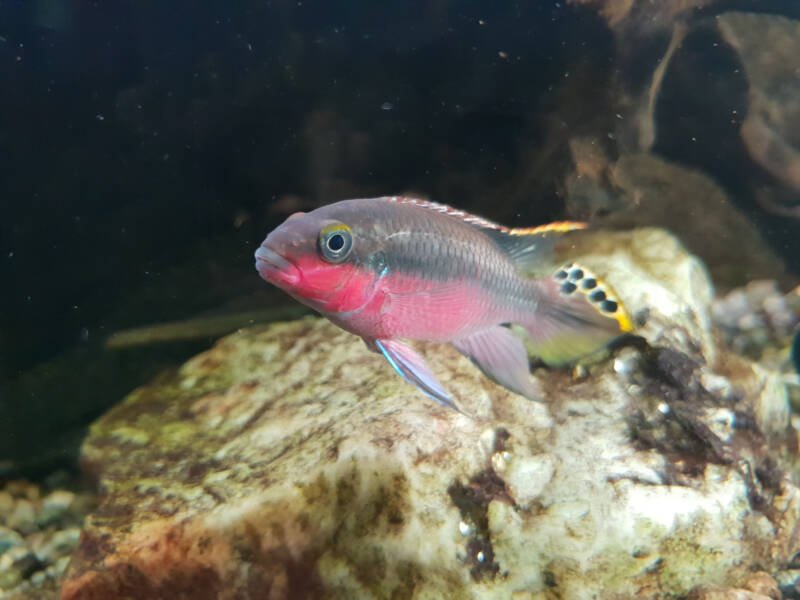
Minimum Tank Size: 20 gallons
The kribensis is a dwarf cichlid, maxing out at four inches in length (10 cm), that can be quite peaceful if you set up the right environment.
Both the angel and krib are semi-aggressive and cramped conditions will lead to stress and increased aggression.
Keep kribensis in a group of two to four and do not overstock the tank.
These fish are territorial during breeding, so ensure plenty of vegetation and hiding places.
Do not house them with small fish, as they may become targets.
The kribensis can be nippy, so keep an eye on how they interact with your angel.
18. Keyhole Cichlid (Cleithracara maronii)

Minimum Tank Size: 20 gallons
Keyhole cichlids are mild-mannered and a bit shy, preferring to swim around the middle level of the tank and hide when frightened.
In fact, they can change color to better blend into their surroundings.
At an adult size of four inches (10 cm), they can be a calm angel tank mate.
Ask your breeder if the keyhole was wild-caught or commercially bred. This can impact their needed water pH level.
Wild cichlids favor highly acidic waters, while commercial bred prefer closer to neutral, which is compatible with the angel.
Keep the water hardness on the lower end of the keyhole’s tolerance.
19. Odessa Barb (Pethia padamya)

Minimum Tank Size: 30 gallons
You will find Odessa barbs actively investigating all levels of the tank.
These three-inch-long (7.6 cm), uniquely colored fish prefer a group size of at least five and plenty of swimming space.
Water parameters match well with the angelfish’s and they have equally hefty appetites for similar foods.
The Odessa is semi-aggressive, but that is typically confined to males establishing dominance.
They can sometimes be nippy, and the flowing fins of your angel may be tempting.
Keep an eye on interactions in the tank and be ready to adjust the mix as needed.
20. Kuhli Loach (Pangio kuhlii)
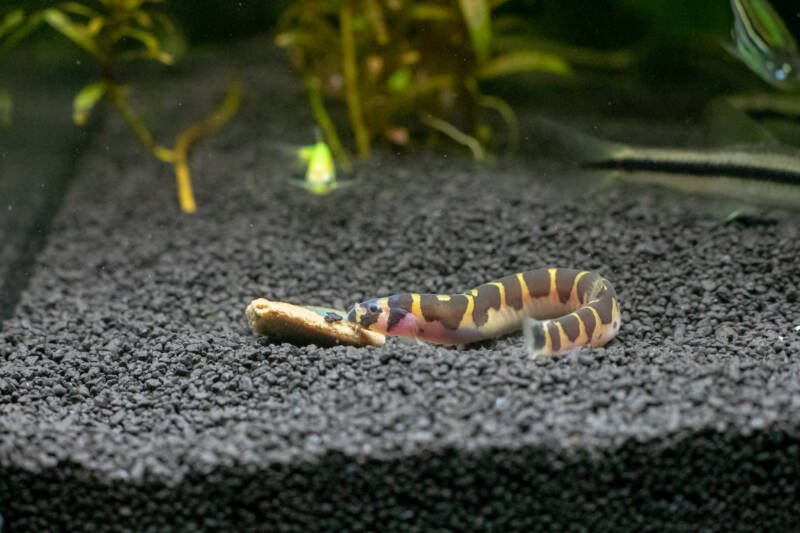
Minimum Tank Size: 15 gallons
Peaceful and non-territorial, the kuhli loach is an ideal angel partner.
Because these loaches roam at night and hide during the day, they will not impede your angel’s daytime activities.
The kuhli loves its water warm, acidic, and soft, so they match well with angelfish in that respect.
This species needs a group of at least three to be most confident and plenty of hiding spaces in which to shelter.
They can be prone to illness if the water conditions are poor and may be outcompeted by your angel when it comes to food, so keep an eye on both.
21. Zebra Danio (Danio rerio)

Minimum Tank Size: 10 gallons
Zebra danios and angelfish are compatible if several conditions are met.
First, keep your danios in a school of at least five or six for better behavior and less fin nipping.
Be ready to rearrange the living situation if the danios are picking at your angels.
Next, choose a large tank. Although these are smaller fish, around two inches in length (5 cm), they are high-energy, active swimmers that will be cranky in a small tank.
Finally, due to the size difference between the angel and danio, choose larger danios and smaller angels so that your angelfish do not consider the danios as food.
22. Honey Gourami (Trichogaster chuna)
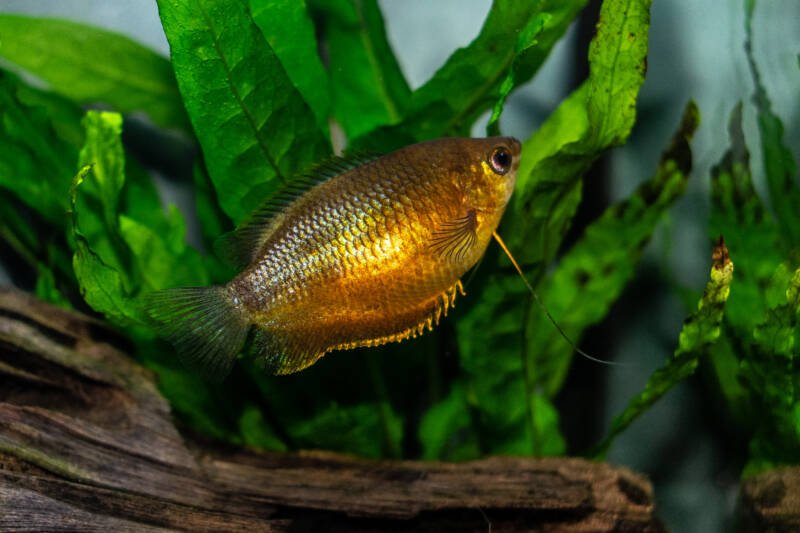
Minimum Tank Size: 10 gallons
The honey gourami is small species whose shy and gentle nature makes them a decent angelfish match.
As an adult, they are only two inches in length (5 cm), so pair larger gouramis with smaller angels and make sure your angels are not picking on them.
Keep this fish in a group of four to six in a well-planted tank with plenty of hiding spaces.
This increases their comfort level, and they will visit all levels of the water column, surfacing every now and then to breathe.
This species exhibits some hierarchical aggression, but their actions should not impact your angelfish.
23. Swordtails (Xiphophorus helleri)
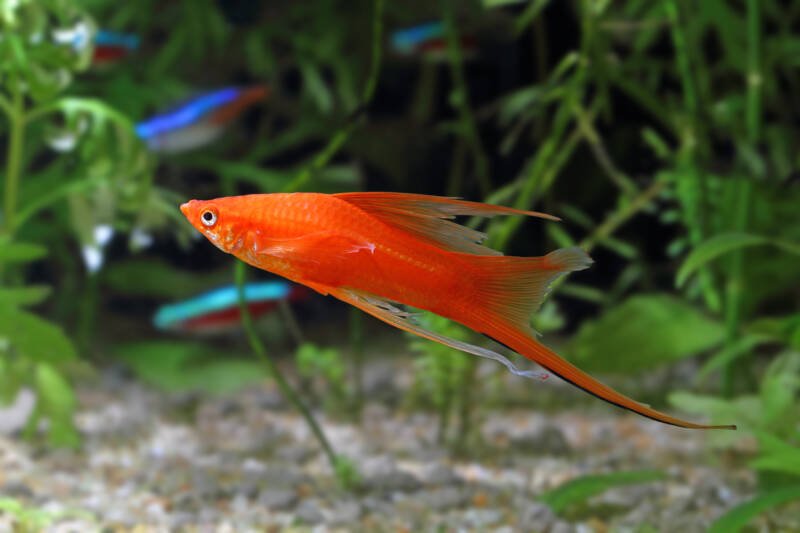
Minimum Tank Size: 15 gallons for a single fish
For the swordtail, tank size matters. A small tank leads to increased aggression.
Keep a ratio of one male to four females to temper infighting.
Another live-bearing species, take care when pairing them with angels if you wish to raise the fry. These tiny treats will be too tempting for your angel to pass up.
Water parameters will be difficult to maintain with this pairing. Keep the pH right at neutral as the angel prefers slightly acidic and the swordfish slightly alkaline.
The hardness should be at the higher end of the angelfish’s range and the lower of the swordtail’s to overlap.
24. Zebra Loach (Botia striata)

Minimum Tank Size: 30 gallons
Zebra loaches are quite compatible water-wise with your angel, just be sure to include a sandy substrate in the tank to protect your loach’s soft belly.
Pair the zebra with caution and watch interactions within the tank as these fish have a reputation for fin nipping.
Keeping an appropriately sized group of at least five loaches may help limit the nipping.
With this group size, they should mind their own business and happily hang out at the bottom of the water column.
As with any bottom dweller, make sure to include some sinking pellets that will make it past your hungry angels.
25. Platies (Xiphophorus)

Minimum Tank Size: 10 gallons
Platies are small, reaching a length of 2.5 inches (6 cm), but their peaceful nature makes them excellent community fish.
They are quite active, which may overwhelm your angel. Watch their interactions to see how well they tolerate each other.
Keep the pH on the acidic side of the platy’s range and the hardness on the lower end to better match with the angel’s water parameters.
Keep one male for every two or three females to reduce the male’s competitive aggression.
Platies are livebearers that breed frequently, and the angels may consume the fry. Separate your platies if you wish to breed them.
26. Tetras (Hyphessobrycon genus)
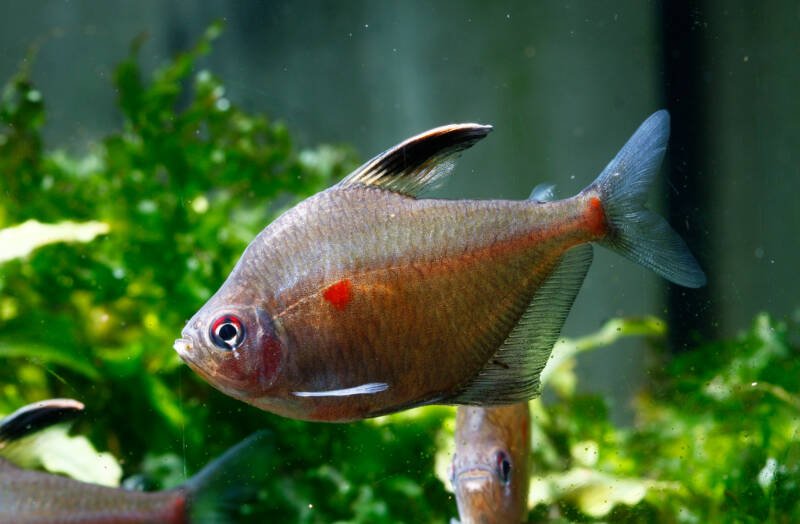
Minimum Tank Size: 20 gallons
When pairing angelfish with tetras, avoid small species, such as the neon or cardinal tetra. The angel may find it tempting to snack on these tiny fish.
Instead, consider the bleeding heart or lemon tetra. These fish grow between two to three inches in length (5-7.6 cm), so your angel should not consider them as food.
They also have delightfully calm personalities that lead to a peaceful tank.
Also avoid tetra species with a reputation for fin nipping, such as the serpae. Repeated nipping will lead to aggression from the angelfish.
If possible, raise the angelfish and tetras together for increased tolerance.
Closing Thoughts
Do not let the angelfish’s reputation as a “difficult to match” fish deter you from your dream aquarium.
Knowing a little about the fish’s temperament, tank needs, and the behaviors of potential tank mates is vital.
As you can see from our list, there are numerous species that will pair well with your angel. Always keep in mind the needs of the fish and keep an eye on interactions within the tank.
Best of luck!
We would love to hear about your angel tanks!
What fish do you have success pairing with angelfish?